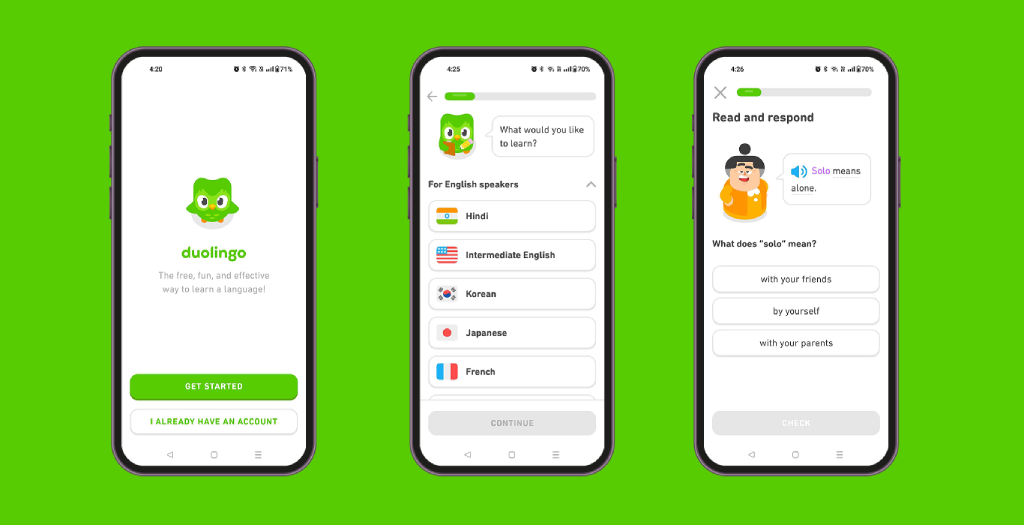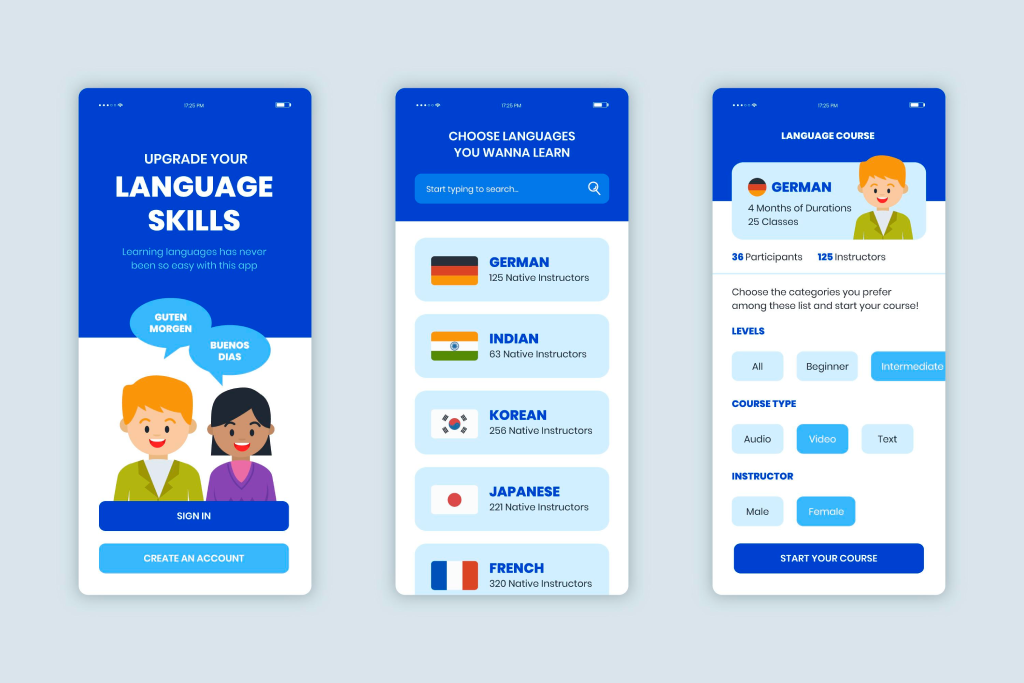Table of Contents
ToggleThe cost to build a language learning mobile app like Duolingo can range from $25,000 for a simple MVP to well over $100,000 for a fully-featured, AI-powered platform.
That might sound like a big gap, but it reflects the difference between launching a lean starter mobile app and creating a global-scale learning experience.
And here’s why that investment could be worth every penny: language learning is no longer confined to classrooms or textbooks.
According to Statista, the global e-learning market is set to reach nearly USD 400 billion by 2026, while the Learning Management System (LMS) market alone is expected to generate USD 18 billion.
With the demand for mobile apps for learning languages in 2025 growing faster than ever, now is an ideal moment to step into the market.
In this guide, I will take you behind the scenes of Duolingo-style app development, what makes it tick, the language learning app features that keep users coming back, the best tech stack for language app creation, and a clear breakdown of the Duolingo mobile app development cost.
Think of it as your complete education mobile app development guide, from idea to launch, designed to help you plan smart, build fast, and stand out in a competitive space.
Cost Breakdown for Duolingo-like App Development
Before exploring the education mobile app development process, it’s important to understand the cost behind building a language learning app like Duolingo.
This not only helps you budget effectively but also allows you to prioritize features that truly matter to your target audience.
The budget to build a language app like Duolingo depends on several factors, including features, complexity, design quality, and the region where your development team is based.
| Complexity | Features Included | Estimated Cost | Timeline |
| MVP | Basic language learning app features, limited gamification | $25,000 – $40,000 | 3–5 months |
| Mid-Level | Advanced gamification, voice recognition, language app functionality, and personalization | $50,000 – $80,000 | 5–8 months |
| High-End | Full AI integration, AR/VR, social learning | $100,000+ | 8–12 months |
Actual costs will vary based on your chosen tech stack, design complexity, and whether you go native or cross-platform.
To explore detailed pricing across various educational app categories, check out our guide on how much it costs to develop an education mobile app.
Features of a Language Learning Mobile App Like Duolingo
When it comes to Duolingo-style mobile app development, the right features are what turn an ordinary app into an addictive learning experience.
The goal is to create a platform that not only teaches but also motivates, entertains, and adapts to every learner’s needs.
Below are the essential language learning mobile app features that modern users expect:
1. Gamified Learning Experience
Gamification in language mobile apps makes studying as engaging as playing a game. Points, streaks, badges, and achievement levels give users a sense of accomplishment, while daily goals and challenges keep them coming back.
This game-like approach transforms language learning from a chore into a rewarding activity.
2. Bite-Sized Lessons
Modern learners value flexibility, and microlearning delivers it perfectly. Lessons are short, focused, and easy to complete during a coffee break or commute, ensuring steady progress without overwhelming the user.
3. Voice Recognition
A voice recognition language mobile app allows learners to practice speaking and get real-time pronunciation feedback.
This is vital for improving fluency, building confidence, and ensuring users can hold real-world conversations.
4. AI-Driven Personalization
An AI-powered language learning mobile app adapts lesson content to the learner’s progress, strengths, and weaknesses.
AI can suggest specific topics, adjust difficulty levels, and even recommend revision exercises for a truly custom experience.
To see how AI is reshaping other industries, check out How AI is taking over healthcare mobile apps? for real-world examples and insights.
5. Leaderboards & Challenges
Adding leaderboard gamification language apps elements, such as rankings, competitions, and friend challenges, encourages consistent participation.
This social and competitive angle pushes learners to practice more often to improve their standings.
6. Offline Learning
An offline mode allows users to download lessons and continue learning without internet access.
It’s especially useful for travelers, students in rural areas, and anyone who wants to study on the go without data constraints.
7. Push Notifications & Reminders
Push notifications act like a personal coach in the learner’s pocket. They can remind users to complete daily lessons, alert them about streak milestones, or notify them of upcoming challenges.
Well-timed reminders prevent drop-offs and help users form a consistent learning habit.
8. Social Media Integration
Integrating popular platforms enables users to share achievements, invite friends, and form study groups online.
This not only fosters community learning but also works as organic marketing; each shared milestone can inspire someone else to join the Learning mobile app.
9. Multi-Language Support
Offering multiple languages within the same app broadens your market reach. Instead of focusing on just one language, allow users to choose from a wide range, making your learning mobile app valuable for individuals, schools, and corporate clients seeking multilingual training solutions.
10. Social Learning
People learn better together. Social learning features allow users to connect with peers, form study groups, and engage in language exchange sessions.
This peer-to-peer practice creates a collaborative environment where learners can motivate each other and improve conversational skills.
Tech Stack Required to Build a Learning Mobile App Like Duolingo
Think of your tech stack as the DNA of your educational mobile app; it determines how it looks, feels, performs, and evolves.
Here’s what a winning language learning mobile app tech stack looks like:
1. Frontend Development – React Native & Flutter
React Native is an ideal choice because it allows you to build a single codebase for both iOS and Android, saving time and reducing the MVP language learning app cost.
It delivers near-native performance, supports smooth animations, integrates easily with gamification, AI, and voice recognition language mobile app features, and has a massive community for ongoing support.
Flutter is another great alternative for rich UI experiences.
2. UI/UX Design – Figma, Adobe XD, Sketch
Great design drives engagement. Tools like Figma and Adobe XD help create a language mobile app UI/UX design that’s intuitive, visually appealing, and aligned with modern mobile educational app trends in 2025.
3. Backend Development – Node.js, Django, Laravel
A strong backend ensures smooth real-time interactions, secure data handling, and easy scalability for millions of learners.
4. Database – MongoDB, PostgreSQL, Firebase
Choose a database that supports fast queries, secure storage, and real-time syncing for user progress, scores, and lesson data.
5. Cloud Storage & Hosting – AWS, Google Cloud, Azure
Store and deliver lesson videos, audio recordings, and AI models with reliable uptime and global accessibility.
6. AI/ML Tools – TensorFlow, OpenAI API
These include power personalization, instant grammar checks, translation features, and adaptive learning paths for an AI-powered language learning mobile app.
Selecting the best tech stack for language mobile app development is like choosing the right fuel for your engine; get it right, and your learning app runs smoothly, adapts quickly, and scales effortlessly as you grow.
Step-by-Step Process to Build a Learning Mobile App Like Duolingo
Step 1: Market Research
Start by understanding your audience and competition. Analyze top apps like Duolingo to see what they do well and where they fall short.
Look for gaps you can fill, whether that’s niche languages, unique learning formats, or enhanced language learning app features.
Solid research ensures your Duolingo-style mobile app development is guided by real market needs, not assumptions.
Step 2: Wireframing & Language App UI/UX Design
Create wireframes to map out your app’s structure, navigation, and lesson flows. Prioritize a clean, intuitive language app UI/UX design that’s visually engaging and easy to navigate.
Make sure your layouts accommodate subscription-based language app monetization without disrupting the learning experience.
Best practices for designing a language learning app:
-
- Keep lesson screens uncluttered to avoid cognitive overload.
- Use friendly, motivational color schemes.
- Include progress bars, streak counters, and badges to encourage consistent use.
- Make navigation simple; users should reach any lesson in 2–3 taps.
- Ensure buttons and interactive elements are thumb-friendly for one-handed use.

Step 3: Language Learning Mobile App Development
With your designs locked in, it’s time to turn vision into a fully working app. Using React Native gives you the advantage of building once and launching on both Android and iOS, saving weeks of work.
Language learning mobile app development happens across three main layers:
- Frontend: This is the “face” of your app, every button pressed, lesson completed, and leaderboard scrolled. React Native makes these interactions smooth and consistent while enabling features like offline access, streak reminders, and in-app voice recording for pronunciation practice.
- Backend: Think of it as your app’s command center. It manages everything users don’t see, lesson logic, progress tracking, subscription handling, and instant updates for challenges or leaderboards. Built with frameworks like Node.js or Django, it ensures the app responds quickly and securely.
- Database: The memory of your app. It keeps track of users, lessons, scores, streaks, and achievements. Using solutions like PostgreSQL, MongoDB, or Firebase ensures fast lookups, secure storage, and smooth syncing across devices.
When these three work in harmony, your educational mobile app doesn’t just function; it delivers a smooth, engaging learning experience from the first tap.
Step 5: Testing of Mobile App Development
Thorough testing ensures your language learning mobile app works easily before launch. Check for performance issues, bugs, and compatibility across devices and operating systems.
Best practices for testing a language learning mobile app:
- Test on multiple Android and iOS devices for consistent performance.
- Simulate poor connectivity to verify offline learning mode.
- Check voice recognition accuracy across different accents.
- Validate that progress tracking and streaks update correctly.
- Conduct user acceptance testing (UAT) with real learners for feedback.
- Ensure push notifications are timely and non-intrusive.
Step 6: Launch your Language Learning Mobile App
Once testing is complete, it’s time to release your learning mobile app on the Google Play Store and Apple App Store. Prepare engaging app store listings with optimized keywords, high-quality screenshots, and demo videos.
Plan a launch campaign that may include social media promotions, influencer partnerships, or early-bird offers to attract initial users. Post-launch, track analytics and gather feedback for continuous improvement.
Monetization Strategies for a Language Learning App
A well-planned monetization language learning mobile app strategy is essential for turning your platform into a sustainable business.
Here are some proven approaches:
1. Subscription-Based Language App
Offer monthly or annual subscription plans that unlock premium lessons, advanced features, or exclusive learning paths. This model ensures a steady revenue stream and encourages long-term user retention.
2. In-App Purchases
Sell additional courses, specialized content, or skill-based modules. Users can pay for features like advanced grammar packs, conversational practice modules, or certification exams.
3. Ads & Sponsorships
Collaborate with relevant brands to display non-intrusive ads or run sponsored content. For example, travel companies or book publishers could partner to promote their services to your language-learning audience.
4. Corporate Training
Offer bulk packages to companies looking to train employees in specific languages. This B2B approach often leads to high-value contracts and long-term partnerships.
A smart mix of these models can maximize revenue without compromising the learning experience, keeping both free and paid users engaged.
Once you’ve learned how to build a language learning app and what it costs, the next logical step is identifying the right developers. A dedicated Mobile App Development in Jaipur can bring your idea to life with a robust, intuitive app built to meet both user expectations and industry standards.
How Alphaklick Helps You Build a Language Learning Mobile App
Your language learning mobile app idea is ready to take off, but you need it built fast, polished, and available on both Android and iOS.
You don’t want months of delays, bloated budgets, or clunky performance.
That’s where Alphaklick comes in.
We are a React Native mobile app development company in India that knows how to turn an idea into a smooth, addictive learning experience. With React Native, we write once and launch everywhere, giving you the speed of a startup and the quality of an enterprise app. From gamified challenges and AI-powered lessons to effortless voice recognition, we build features that keep learners coming back every day.
We handle the tech, the design, and the launch with post support maintenance so you can focus on building your audience.
Book a consultation call, and we will make it happen, fast, beautiful, and ready to scale.
Frequently Asked Questions (FAQ)
Question: Is the language learning mobile app profitable?
Answer: Yes, with the right monetization language learning mobile app strategy, it can be highly profitable. Many educational mobile apps earn steady revenue through subscriptions, in-app purchases, corporate training packages, and brand partnerships, especially when paired with strong user engagement and retention features.
Question: How long does it take to build a mobile app like Duolingo?
Answer: On average, interactive lessons mobile app development takes around 4–8 months, depending on the complexity of features, design requirements, and whether you are building an MVP or a fully-featured platform. Cross-platform frameworks like React Native can speed up this timeline.
Question: How much does it cost to develop an e-learning mobile app in 2025?
Answer: The cost ranges from $10,000 to $85,000+, depending on features, design, and platform. Advanced options like AI, AR/VR, or gamification may increase the budget. Check our e-learning mobile app development guide for a full breakdown.
Question: How Much Does It Cost to Develop an Education Mobile App?
Answer: The cost to develop an education mobile app can range between $20,000 and $120,000.
Question: How do I choose the right company among top mobile app development companies in India?
Answer: Look at their portfolio, client reviews, tech expertise, and delivery track record when selecting from the top mobile app development companies in India.

